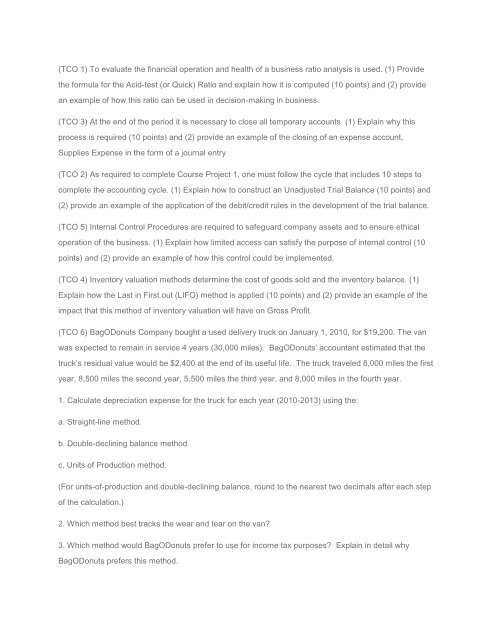ACCT 212 DEVRY ENTIRE COURSE LATEST
Create successful ePaper yourself
Turn your PDF publications into a flip-book with our unique Google optimized e-Paper software.
(TCO 1) To evaluate the financial operation and health of a business ratio analysis is used. (1) Provide<br />
the formula for the Acid-test (or Quick) Ratio and explain how it is computed (10 points) and (2) provide<br />
an example of how this ratio can be used in decision-making in business.<br />
(TCO 3) At the end of the period it is necessary to close all temporary accounts. (1) Explain why this<br />
process is required (10 points) and (2) provide an example of the closing of an expense account,<br />
Supplies Expense in the form of a journal entry<br />
(TCO 2) As required to complete Course Project 1, one must follow the cycle that includes 10 steps to<br />
complete the accounting cycle. (1) Explain how to construct an Unadjusted Trial Balance (10 points) and<br />
(2) provide an example of the application of the debit/credit rules in the development of the trial balance.<br />
(TCO 5) Internal Control Procedures are required to safeguard company assets and to ensure ethical<br />
operation of the business. (1) Explain how limited access can satisfy the purpose of internal control (10<br />
points) and (2) provide an example of how this control could be implemented.<br />
(TCO 4) Inventory valuation methods determine the cost of goods sold and the inventory balance. (1)<br />
Explain how the Last in First out (LIFO) method is applied (10 points) and (2) provide an example of the<br />
impact that this method of inventory valuation will have on Gross Profit.<br />
(TCO 6) BagODonuts Company bought a used delivery truck on January 1, 2010, for $19,200. The van<br />
was expected to remain in service 4 years (30,000 miles). BagODonuts’ accountant estimated that the<br />
truck’s residual value would be $2,400 at the end of its useful life. The truck traveled 8,000 miles the first<br />
year, 8,500 miles the second year, 5,500 miles the third year, and 8,000 miles in the fourth year.<br />
1. Calculate depreciation expense for the truck for each year (2010-2013) using the:<br />
a. Straight-line method.<br />
b. Double-declining balance method.<br />
c. Units of Production method.<br />
(For units-of-production and double-declining balance, round to the nearest two decimals after each step<br />
of the calculation.)<br />
2. Which method best tracks the wear and tear on the van?<br />
3. Which method would BagODonuts prefer to use for income tax purposes? Explain in detail why<br />
BagODonuts prefers this method.

















